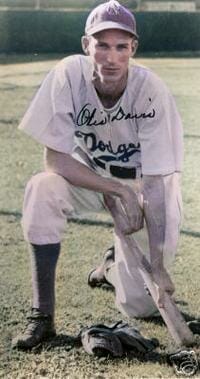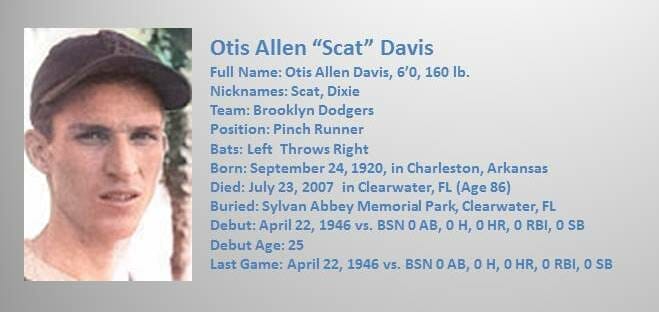

Uh oh...
It appears that you're using a severely outdated version of Safari on Windows. Many features won't work correctly, and functionality can't be guaranteed. Please try viewing this website in Edge, Mozilla, Chrome, or another modern browser. Sorry for any inconvenience this may have caused!
Read More about this safari issue.

Baseball breaks your heart. It is designed to break your heart.
– Former Commissioner of Baseball Bart Giamatti
A “Cup of Coffee” in major league baseball has become an unfortunate phrase that trivializes a very short big-league career. Of those brief big-league stays, a thousand or so men played only one game at baseball’s highest level. In approximately two dozen of these brief Cup of Coffee careers, the player did not pitch, come to bat or play in the field. Those poignant biographies include one speedy young man from Charleston, Arkansas.
Scat Davis played in the major leagues, a dream for every boy who ever picked up a bat and glove. To those who dream the dream as youngsters, the length of their major league career never comes into question. In the dream, they play lengthy, distinguished careers filled with last inning walk-off home runs or World Series no-hitters. In the dream, they bask in the adoration of loyal fans and become renowned superstars in the game they love.
For those fortunate enough to realize some variation of the dream, fulfilled by actually reaching the big leagues, the reality is often much less grandiose. These less distinguished major league careers are nonetheless treasured by former major leaguers. Each time at bat, or the simple act of trotting out to play in the field in a major league ballpark, is permanently recorded as a cherished memory. At least that is the case with almost every man who ever donned a major league uniform.

Otis “Scat” Davis was born in 1920 near Charleston, Arkansas. The son of a coal miner, he was born just in time for some of rural Arkansas’s toughest years. The Great Depression hit the rural South hard. Davis’ mother died in 1929, and his father struggled to feed five children as a single parent. He later recalled, in an interview with baseball historian Jim Sargent, that because he was needed to help support the family, it took him a few extra years to finish high school.
Davis had excelled in all sports at Charleston High School. And since baseball was the only sport that offered a way to play for money, he took a chance. After graduation, he found his way to the Ban Johnson Amateur League in the Kansas City area. Davis was playing with Maryville in the BJL in 1941 when the Cardinals discovered him and offered him a contract.
Scat Davis spent the 1942 season traveling the Cardinal farm system from Louisiana to West Virginia, and finally to Canada, where he finished the season. By late summer he was batting .281 in about 100 at-bats with Hamilton when the reality of the times came calling. In early August, like so many young men in America, he enlisted in military service with the US Navy.

Otis Davis could run. Early in his career, he had earned the nickname “Scat” because of his speed. His ability to run the bases well and chase down potential hits in the outfield was astonishing, considering he seriously injured his knee in high school. The knee was so bad, in fact, that the Navy soon granted Davis a medical discharge because his knee would not hold up in basic training. Before the knee repairs that are commonplace today, Scat Davis played his entire career with the troublesome knee.
The Cardinals sent Davis back to the PONY League for the 1943 season where he hit .328 and earned a promotion to Rochester. The 1944 season was a huge jump in the quality of competition. Davis’ batting average fell to .241, although he was in the lineup almost every day.
In 1945, the Cards tried Davis at Rochester again to start the season, and once again he seemed overmatched. He was hitting under .200, when the Cardinals sent him down to Allentown, Pennsylvania in the Class B Interstate League. Scat Davis caught fire in Allentown. He was able to get in 55 games and batted .350 in the second half of the season. Although the war was ending, and the pro baseball players in the military would be coming home the next spring, Davis had earned a good look by the Cardinals in 1946.
When the Cardinals left Florida for St. Louis after spring training in 1946, 25-year-old Scat Davis was on the train. Davis’ time in St. Louis was brief, however, and he never saw the field in the three games he sat on the Cardinals’ bench. A transaction notice ran in the sports pages on April 20, announcing Davis had been sold to the Dodgers the previous day for the minimum wavier price of $7,500.
Scat Davis arrived in Brooklyn to join the Dodgers while they were playing a weekend series with the crosstown New York Giants. Davis did not play in the series, but he made his debut on Monday, April 22nd, when the Dodgers started a series with a day game against the Boston Braves.
Boston had built a 4 – 2 lead going into the bottom of the 9th inning. With some younger players in the lineup, Durocher still had some of his veterans on the bench. One of these veterans was Eddie Stanky, a crafty hitter, who had set a league record with 148 walks in 1945. Stanky would lead the league in walks again in 1946. And predictably, when called on to pinch-hit for the pitcher in the ninth, Stanky walked.
Durocher sent Scat Davis in to run for Stanky, to get a faster runner on base. Davis moved to second when another pinch hitter, rookie Bob Ramazzotti, also walked. With runners on first and second, future Hall of Famer Billy Herman fouled off two bunts before getting one successfully down to advance Davis and Ramazzotti. Davis raced toward third on all three bunt attempts. And on one of the 90-foot sprints and slides into third, he reinjured his bad knee. Davis stayed in the game and limped home on a double later in the inning.
When Boston failed to score in their half of the 10th, Billy Herman’s RBI single won the game for the Dodgers. Scat Davis had played in a major league game and taken part in the 9th inning comeback. Although his knee was swollen and sore after the game, he had no reason to fear he had played his last major league game.
A few days later, it was obvious Scat Davis could no longer run on his bad knee. The Dodgers sent the rookie down to Montreal and later to Fort Worth to rehab his tender knee. After a handful of games for each minor league team, Davis knew his knee needed rest. He headed back to his adopted hometown of Rochester, New York, married in August, and settled into retirement from baseball.
Retirement lasted only one winter. After resting his injured knee, Davis had second thoughts. Perhaps motivated by his brief stay in the big leagues, he tried minor league baseball for two more seasons. Although he played well, Davis knew he was a player on the way down rather than on his way to the majors.

Thirteen Arkansans had a one-game “Cup of Coffee” in major league baseball. Only one failed to bat, play in the field or pitch. When Scat Davis was asked if he still had dreams about a different outcome, he answered,
“Moonlight Graham played the field, but he never got to bat. I’d like to have batted, but I could have gone 1-for-1, or I could have struck out.” “Think about this,” Davis added about the opportunity to pinch run, “What if Eddie Stanky had struck out? If he doesn’t get on base, what happens to my shot at the big leagues?”
We do the work.
You check your email.
Sign up for our weekly e-news.
Get stories sent straight to your inbox!









Like this story? Read more from Jim Yeager
For most of the 1964 season, the Arkansas Travelers were the best team in...
At 11:53 p.m. on June 1, a crowd of 11,000-plus at Alex Box Field fell...
Baseball Hall of Famer Bill Dickey was born in Bastrop, Louisiana, on...
Join the Conversation
Leave a Comment